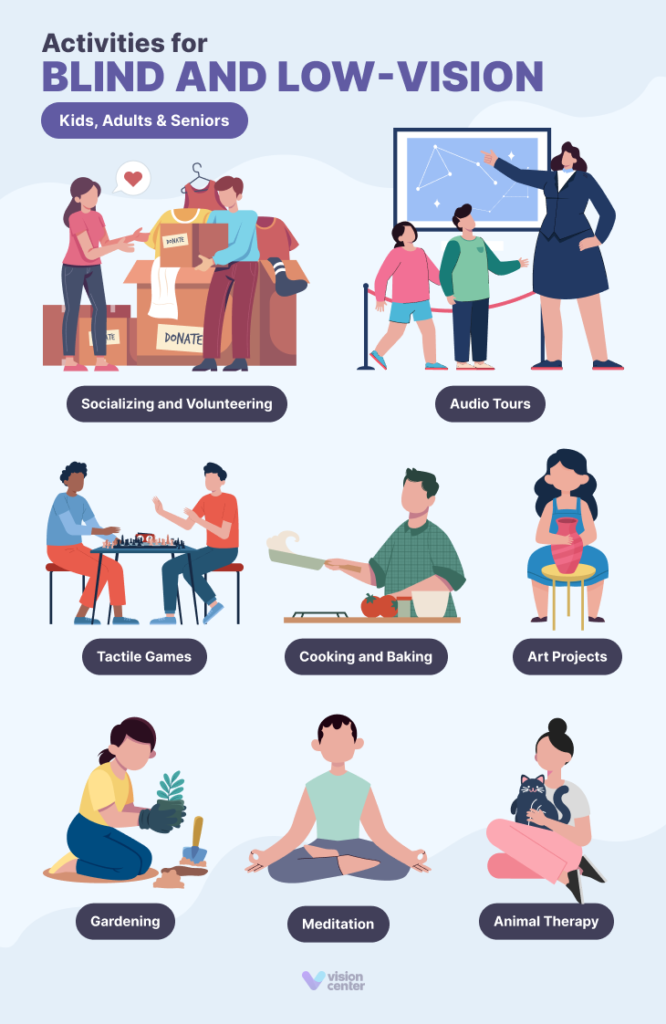
Living a fulfilling life doesn’t require sight. Blind adults have diverse interests and passions just like everyone else, and there are countless ways to engage with the world and find joy. This article explores a range of fun activities specifically designed for blind adults, highlighting opportunities for social interaction, learning, entertainment, and personal growth.
From tactile games that stimulate the sense of touch to immersive audio experiences, we’ll delve into various categories of engaging activities. We’ll also explore adaptive sports that provide thrilling challenges and creative outlets like music and writing that foster self-expression. By embracing inclusivity and accessibility, we can ensure that blind adults have access to a vibrant and fulfilling lifestyle.
Fun Activities for Blind Adults
Blind adults can enjoy a wide array of activities tailored to their unique needs and preferences. These activities cater to diverse interests, promote social interaction, and encourage personal growth.
One key aspect is finding activities that stimulate the senses. Tactile games, sensory experiences, and audio-based entertainment offer engaging ways to connect with the world. Furthermore, accessible technology opens up a realm of possibilities for communication, learning, and entertainment. Blind adults can also participate in adaptive sports, which provide thrilling challenges and opportunities for teamwork and competition.
Tactile Games and Sensory Experiences
Tactile games are designed to engage the sense of touch, providing a unique and interactive experience. Games like Braille chess, tactile dominoes, and 3D puzzles offer stimulating challenges that test strategic thinking and problem-solving skills. These games can be enjoyed individually or in groups, fostering social interaction and friendly competition.
Sensory experiences tailored for blind individuals create immersive environments that engage other senses like hearing, smell, and touch. Guided meditation sessions incorporating soothing soundscapes and aromatherapy can promote relaxation and mindfulness. Interactive exhibits at museums and art galleries designed with tactile elements allow blind visitors to “see” artwork through touch and sound descriptions.
Audiobooks, Podcasts, and Accessible Technology
Audiobooks provide a fantastic way for blind adults to enjoy literature and explore new worlds. With a vast selection of genres available, from fiction to non-fiction, audiobooks cater to diverse interests and reading preferences. Podcasts offer engaging audio content on a wide range of topics, providing informative insights, entertaining stories, and thought-provoking discussions.
Accessible technology plays a crucial role in empowering blind adults. Screen readers allow users to access digital content through auditory output, while Braille displays provide tactile representations of text. Smartphones with voice assistants and apps designed for the visually impaired offer convenient tools for communication, navigation, and information access.
Adaptive Sports for Blind Adults
Adaptive sports provide thrilling challenges and opportunities for physical activity and teamwork. Goalball, a fast-paced team sport played by blind athletes, involves throwing a ball towards the opposing team’s goal while navigating the court using sound cues. Paralympic swimming offers competitive races in various distances and stroke styles, showcasing the incredible athleticism of visually impaired swimmers.
Other adaptive sports include wheelchair basketball, sitting volleyball, and blind skiing. These activities promote physical fitness, teamwork, and a sense of accomplishment. Adaptive sports also foster inclusivity and break down barriers, demonstrating that individuals with visual impairments can excel in competitive environments.
Creative Pursuits for the Visually Impaired
Blind adults can express their creativity through various artistic pursuits. Music offers a powerful outlet for self-expression, allowing individuals to learn instruments like piano, guitar, or drums using tactile methods and auditory feedback. Drama provides opportunities to explore characters, develop storytelling skills, and engage in collaborative performances.
Writing allows blind individuals to share their thoughts, experiences, and imaginations through written word. Braille writing tools and assistive technology make it possible for them to create stories, poems, essays, and even novels. Creative pursuits like painting with textured mediums or sculpting with clay can also provide tactile and sensory experiences that foster artistic expression.
Conclusion
Blind adults have the same desire for fun, engagement, and personal fulfillment as anyone else. By embracing inclusivity and providing accessible opportunities, we can empower them to lead vibrant and meaningful lives. From tactile games and sensory experiences to audiobooks, podcasts, adaptive sports, and creative pursuits, there are countless ways for blind adults to explore their interests, connect with others, and discover new passions. Let’s continue to create a world where everyone has the chance to thrive and enjoy life to the fullest.
